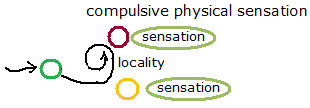The Kuriki method (the first edition in 2007) is a theory about Tourette’s syndrome (tic disorder) and obsessive-compulsive disorder to cure these diseases without medication. This theory is based on the author’s inference and interpretation regarding the structure of these diseases. Since it has been written for the psychoanalysts, reading will be difficult for people in general and it might be sometimes read erroneously. Therefore the Kuriki method must presuppose that the patient is treated by a nearby psychoanalyst, and that, between the patient and the Kuriki method, there is always the psychoanalyst. The explosion of emotional catharsis, which has strong repercussions, is done only for three seconds, once a week: beyond this rhythm, it would be an accident caused by negligence, and the psychoanalyst who is inexperienced in emotional catharsis must take responsibility for the temporary mental collapse caused by the accident. Also, to the patient who has weak capacity of logical reasoning, the psychoanalyst must explain well on the violent emotion of revenge caused by the illusory confusion between the person of the traumatic image in his head and the person in the real world.
Cure for Tourette’s syndrome (tic disorder) and OCD without medication
§28

3. Recursive repressed sensations
In the third phase, as the « compulsive intramuscular sensation » of tic disorder is a repression of disagreeable bodily sensation, the « compulsive intramuscular sensation » can be a repression of the « compulsive intramuscular sensation » on the same part of the body. That is a vicious circle and the « compulsive intramuscular sensation » amplifies itself. For example, when the « compulsive intramuscular sensation » of a shoulder tic appears to repress the « compulsive intramuscular sensation » of a shoulder tic, the « compulsive intramuscular sensation » will amplify itself in that shoulder muscle.
The « compulsive intramuscular sensation » is disagreeable sensation, and become an object of repression. Once the « compulsive intramuscular sensation » is seen in the Conscious, it becomes recursive and amplifies itself in the Conscious. The « compulsive intramuscular sensation » is repression of itself. In this sense, every « compulsive intramuscular sensation » is recursive and amplifying. At the time of an amplification, in the upper layer, primitive sensations are no longer objects of repression. Primitive sensations were only triggers. Awareness of the fact that the « compulsive intramuscular sensation » is a repression of itself will be necessary.
The very frequent repetition of tic movements at short intervals of severe cases patients can be considered as a recursive prolongation, i. e., the disagreeable sensation of one time of « compulsive intramuscular sensation » is not resolved by one time of tic movement. The Absolute-Compulsion has no individual differences in speed or in strength, and only the non-completeness of the resolution can make severe cases. “Resolution” is also a musical term and the severe cases of tic disorder are states where the chord of resolution is a 7th. While the tic movements of severe cases can resemble involuntary movements, all tic movements are voluntary movements.
The « compulsive intramuscular sensation » is fabricated by the Unconscious, but the amplification is done by the Conscious. In this sense, every « compulsive intramuscular sensation » amplifies itself recursively. The amplification can be cut by acts that require mental concentration.
Bodily sensation in obsessive-compulsive disorder
Also, «the compulsive physical sensation» of OCD amplifies itself as being a means of repression of «the compulsive physical sensation» of OCD of the same body part. The Conscious interprets this bodily sensation as a feeling of anxiety, and the Conscious considers the amplification of bodily sensation of OCD as an amplification of the feeling of anxiety. The difference between phobia and obsessive-compulsive disorder is that the object of the fear of obsessive-compulsive disorder is not the bodily fear.
Anti-repression.
Against the amplification of the « compulsive intramuscular sensation » in a vicious circle, you make your Conscious do the conscious repression of the initial « compulsive intramuscular sensation », with the awareness of the primitive bodily sensation (bodily sensation of the genital part, for example).
Localization of disagreeable bodily sensation
The structure of tic disorder localizes the disagreeable « compulsive intramuscular sensation » on definite part of the body. The « compulsive intramuscular sensation » is perceived with its position on the body; the shoulder, the neck, etc. This localization, which is limitation of area, can be compared with the positionally indeterminate bodily suffering, for example, during an intentional stop of breathing, etc., and the Absolute-Compulsion, which can not be bodily perceived. (Cf. § 47, Absolute Compulsion).
A tic movement is forced by the « compulsive intramuscular sensation », however, the « compulsive intramuscular sensation » itself is not unbearably “aching”, and in fact, a tic movement is forced by the amplification of the compulsivity in the Absolute-Compulsion, but the patients with tic disorder perceive this amplification as amplification of the local disagreeable « compulsive intramuscular sensation ».
